Due to damage from the winter storms in 2023, the wharf is currently closed. No date has been set for reopening.
Public Pier — No Fishing License Required
While some piers along the coast (such as Seacliff) have characteristics that help define and give identity to the pier, here it is the area itself that makes the pier special. Supposedly the oldest seaside resort along the Pacific coast, Capitola has, since 1869, been a destination for inlanders headed to the coast. The area today is one of restaurants, stylish tourist shops and art galleries.

The entrance to the wharf
The main area near the beach is really only a few square blocks, but it is made up of commercial buildings, old Victorian houses, a restored railroad depot and, at the front of the pier, a 1920s condominium-type area known as the Venetian Court, complete with pastel colors and ornate architecture. People in Capitola seem to regard their “village” as an up class, perhaps more dignified, version of a beach town, in contrast to Santa Cruz and its weekend hordes.
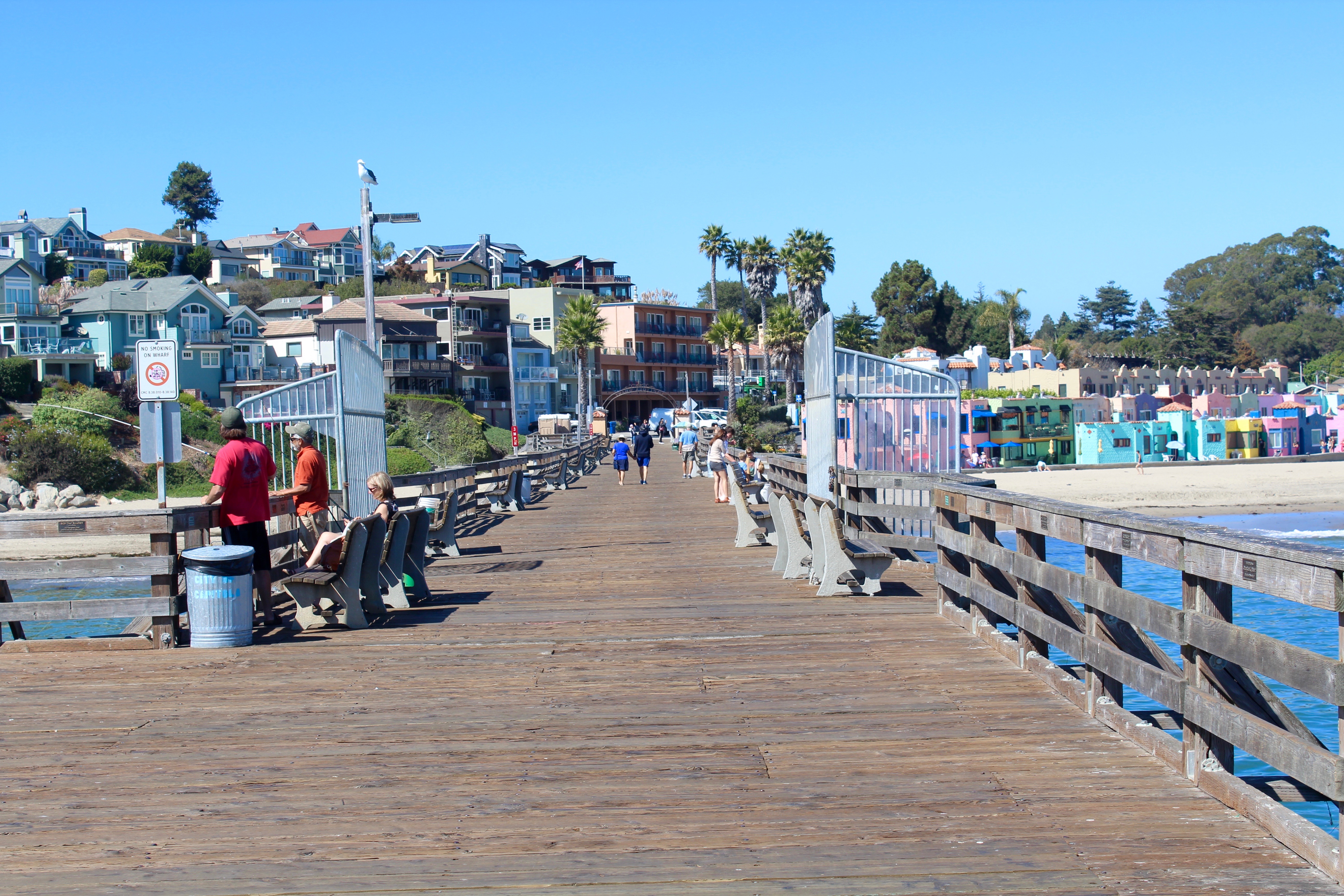
Looking toward shore
Environment. The pier itself is relatively new, having been rebuilt in the mid-1980s following storm damage which nearly destroyed the old pier. Luckily, the new pier is wood (which I always prefer) and although the pier is only 855-foot-long, it is rarely crowded with pier anglers unless there is a “run” of fish present. At such times, railing space can be at a premium. The majority of people on the wharf are visitors out for a stroll or people heading out to the restaurant. Even the majority of fishermen here are, and I’m guessing, boat anglers heading out to fish the nearby reefs. Some come to launch their own boats, some come to rent the boats that are available on the pier. Excellent fishing is found fairly close to the pier for several species.

The shore end of the pier fronts two beaches, Hooper Beach on the north side of the wharf, and Capitola City Beach to the south. Inshore, it’s a typical sandy beach environment with surfperch predominate in the catch. Spring to fall can see striped bass in these inshore waters, especially if the anchovies surround the pier, but it doesn’t happen every year. The inshore area extending out to mid-pier will see halibut (spring to fall) and other smaller flatfish much of the year.
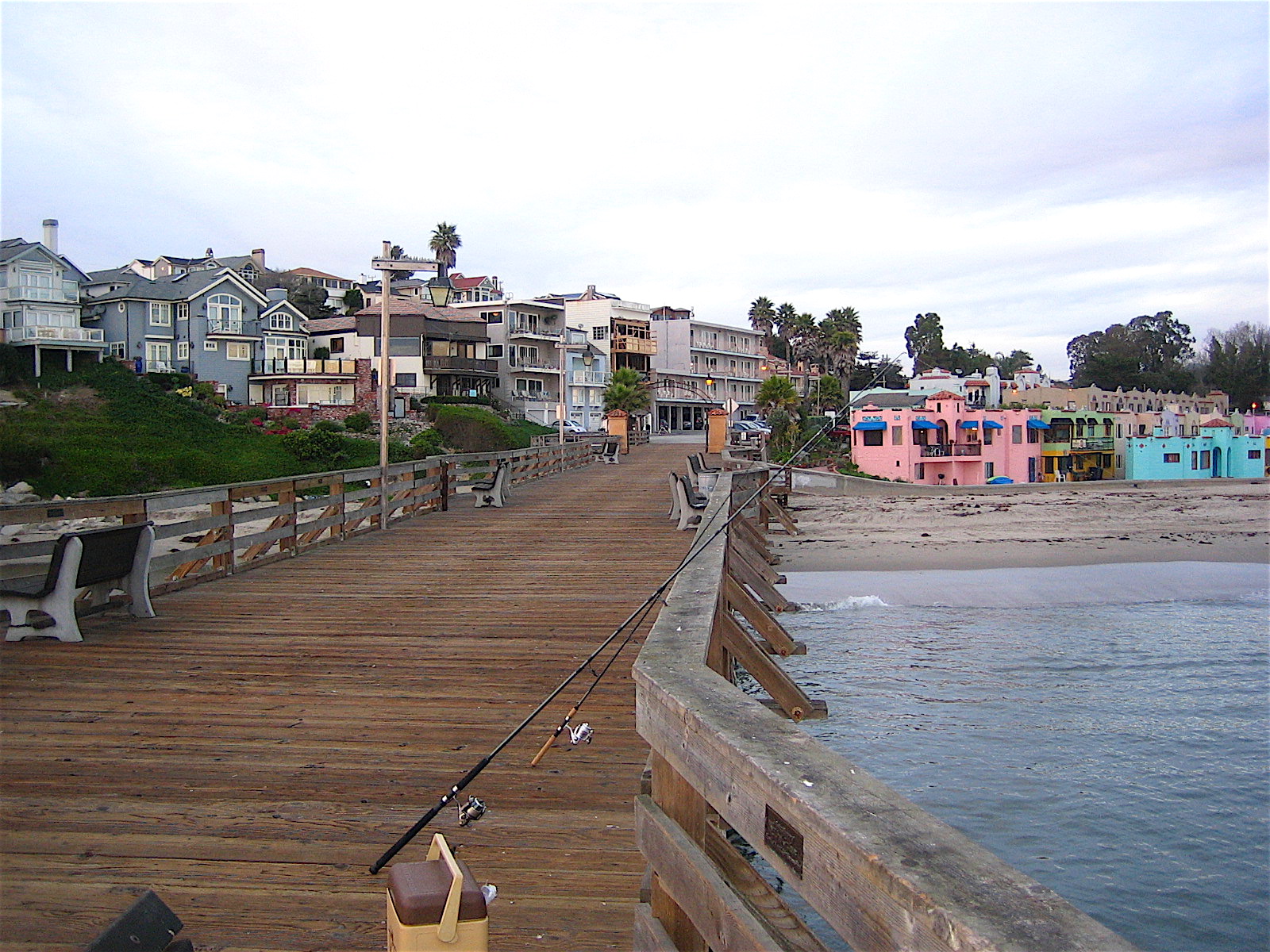
Picture courtesy Aquamonk
Further out on the pier sees a bottom that is a mixture of sand and mud. Pilings have a fair buildup of mussels and there is often a fairly thick buildup of kelp around the pier from the midsummer months to the fall. Fish are attracted to the mussel-encrusted pilings under the pier and the kelp covering that can provide protection.

Picture courtesy Aquamonk
In addition, Soquel Creek runs into the ocean just down the beach from the pier. During the winter, the mouth of the creek stays open, during the summer, it usually closes and a small lagoon, mostly used for swimming, forms just inside the city beach. Because of the creek, most years will see some steelhead caught during the fall and winter months as they wait for the mouth of the river to open.

What all of this means is that an angler is presented several different areas and environments to fish and each can yield different varieties of fish. At the same time, each environment can call for a different approach on the part of the angler.

Rarely seen fish that have been caught in these waters include barracuda, triggerfish, black sea bass (see below) and sturgeon; but your chances of landing one of these are about the same as hitting a Lotto Jackpot. Occasionally though an unusual fish is landed from the pier; one such fish was an American shad that was caught on a Sabiki rig in July 2009.

Looking down at the pier from the public parking area up the hill

A view of Capitola and the Capitola Wharf from the Seacliff Pier
Fish and Fishing Tips. Anglers tend to target four areas for effort—the inshore surf area for surfperch, the area just past the breakers for stripers and halibut, under the pier for perch and other kelp/rock species, and the waters out from the end for a variety of species.
One of the most reliable areas is the surf area, especially on an incoming tide. The result is the larger barred surfperch (reported to three-pounds) and calico surfperch. For these, use sand crabs, pile worms, fresh mussels or small pieces of market shrimp. If you like artificials, try a 1-1/2 to 3-inch plastic grub with root beer, motor oil/red flake, and pumpkin seed patterns often producing the most fish. Two-inch Berkley Gulp! Sand Worms and Minnow Grubs (in pumpkinseed color) can also be productive. By far, the winter and spring months are the best for these perch but some will be caught throughout the year.
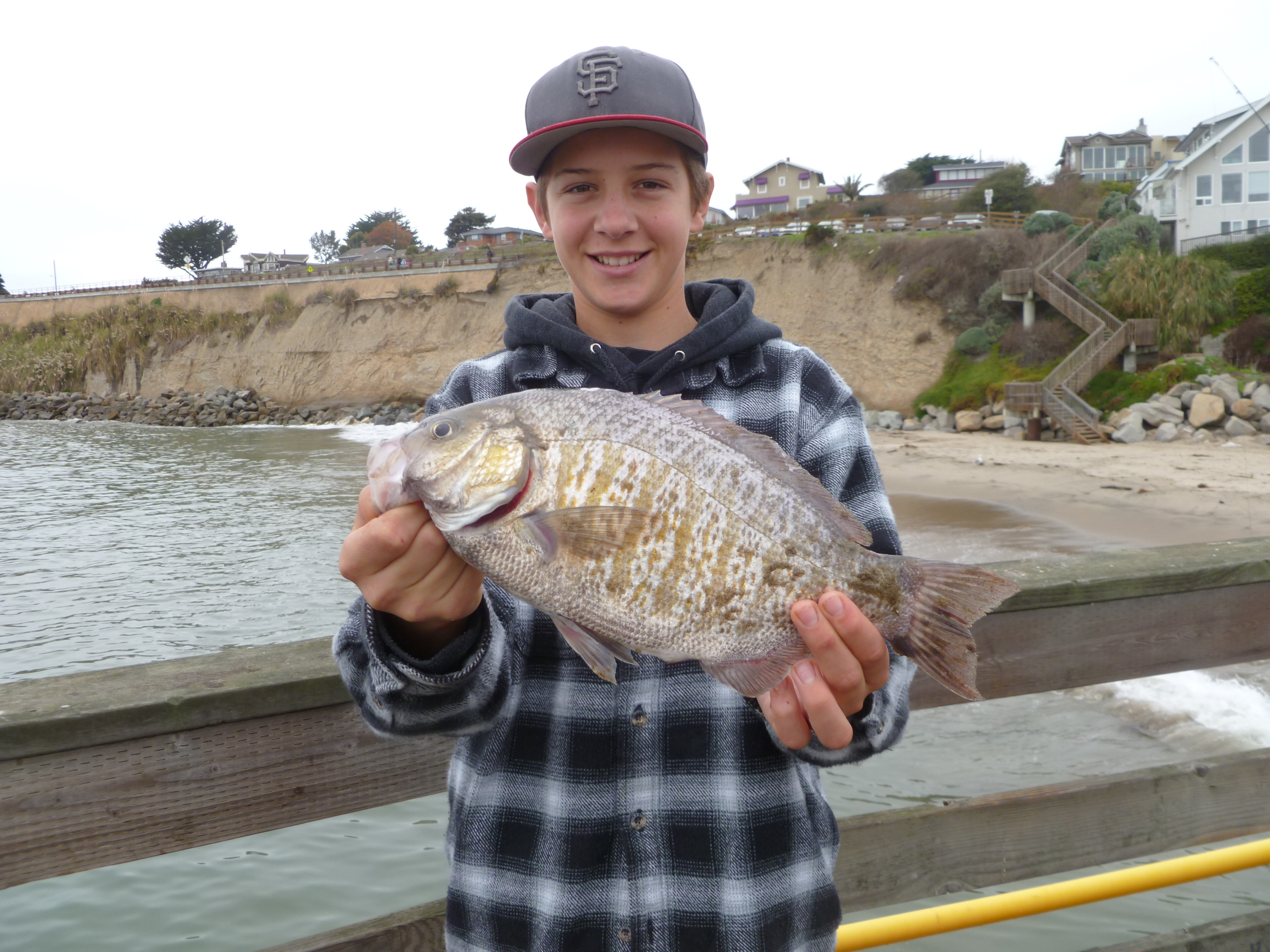
Barred Surfperch — Picture courtesy of Capitola Pier Bait and Tackle
According to Ed Burrell who has worked at the pier’s bait shop, and is “the expert” as far as I’m concerned, “the best perch conditions occur when the water is clear and the wind creates a nice chop on the ocean surface.” Thus in the wintertime the runoff from the nearby Soquel Creek can affect the fishing for the perch, especially if the runoff muddies the water. When it starts to flow south, away from the pier, the bite picks up.

Barred (R) and Calico (L) Surfperch — Picture courtesy of Capitola Pier Bait and Tackle
Outside the surf area to about mid-pier seems to be the best area for both California halibut and striped bass. May through July is usually the prime time for the flatties and most years will see some fairly impressive sized flatfish landed (20+pound size). Most will be caught on live bait such as anchovies, shinerperch, small kingfish, sardines, or small mackerel (some years), and all should be fished on the bottom with live bait rigging (although in the shallows you can also fish them under a float). If you’re not into using bait, a few flatties will also be taken each year on artificials such as Hair Raisers, Big Hammers and Scampis.
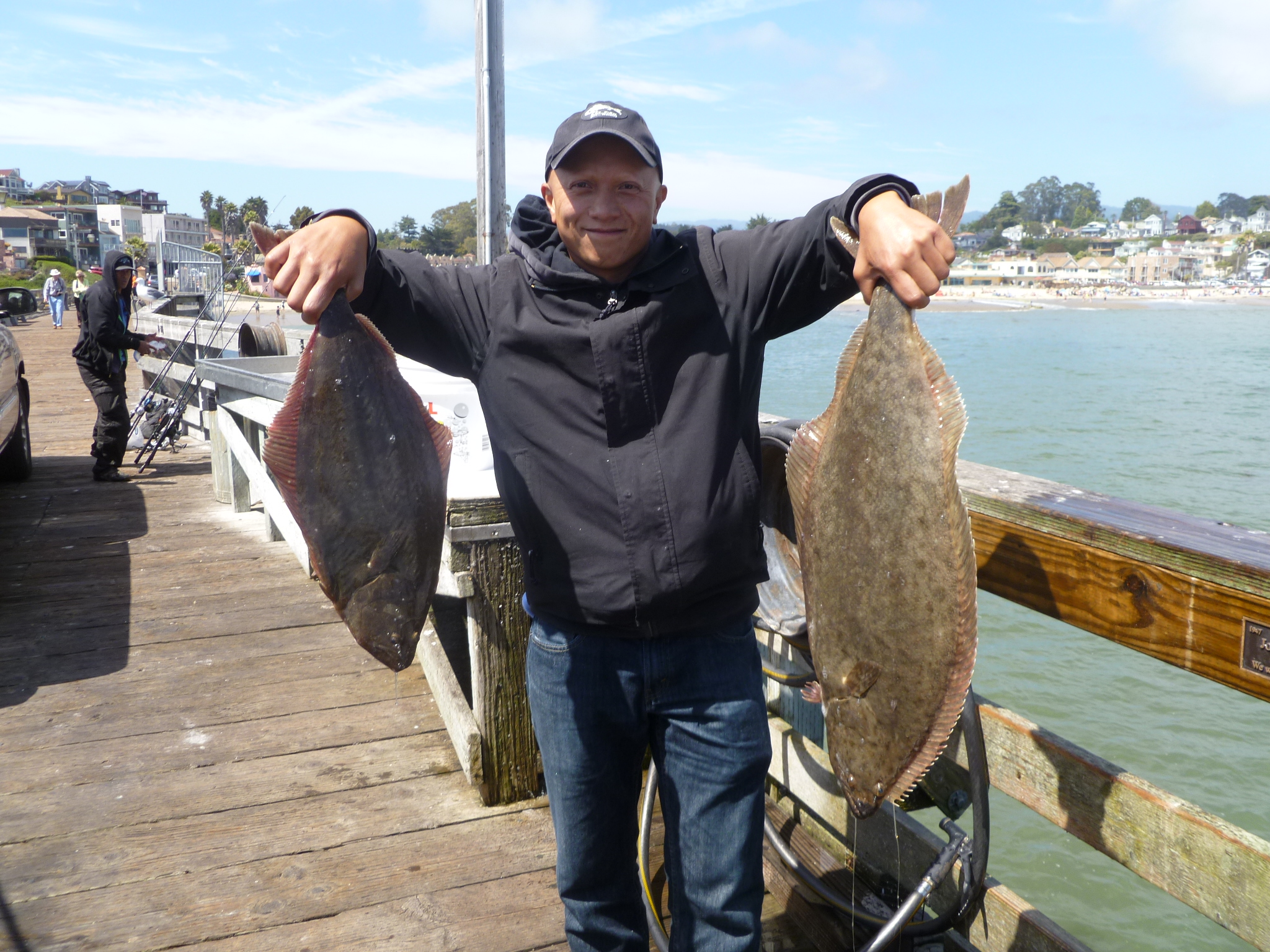
California Halibut — Picture courtesy of Capitola Pier Bait and Tackle
Smaller flatfish—sand sole, starry flounder, Pacific sanddab and diamond turbot—are sometimes also seen in these areas with pile worms fished on a Carolina rig or high/low rigging seeming to produce the most fish. The starries and sanddabs are generally seen winter and spring while sand sole (to four pounds) and the occasional turbot may show up any month.

California Halibut — Picture courtesy of Capitola Pier Bait and Tackle
Similar riggings may also attract a striped bass but they are less particular and will often hit a piece of mackerel or sardine, shrimp, or a pile worm that is graciously offering up its life so that our noble anglers can experience the thrill of a striper. Most of the stripers range from 8-15 pounds but bigger ones are caught (including a 31-pound fish in September of 1995. November of 1997 proved especially interesting when a school of about 70 stripers came into the shallow water by the pier and teased the anglers on the pier; only a couple were caught. 2004 saw a huge run of fish that lasted for several weeks. Keeper fish were caught daily with a 27-pound fish apparently leading the way (although a 28-pound striper was caught on a Pencil Popper adjacent to the wharf).
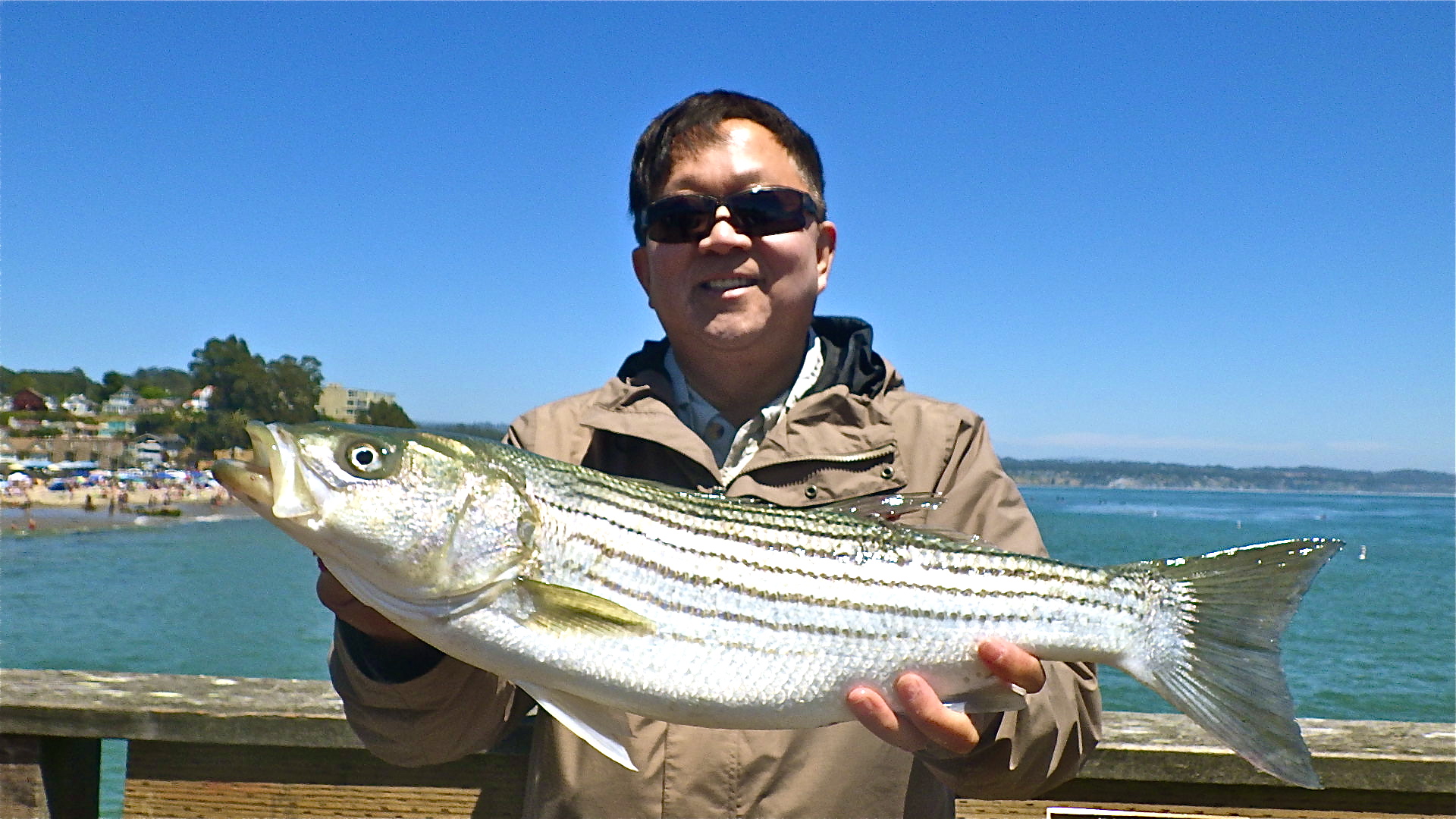
Striped Bass — Picture courtesy of Capitola Pier Bait and Tackle
Ditto 2005 when the stripers pushed anchovies up against the beach and feasted on the bait. Anglers used bait rigs to catch anchovies and then fished them under bobbers for the stripers. In fact, stripers have shown up every summer since 2004 and every year has seen 20+pound fish landed, and some that approached 30 pounds. The summer of 2009 saw stripers become regular visitors to the pier. Regulars on the pier used bait rigs to catch live sardines that were used for bait; the result was daily landing of stripers topped by a 29-pound fish in late July.

Striped Bass — Picture courtesy of Capitola Pier Bait and Tackle
Fishing under the pier, by the pilings, is a time honored pier tradition and here it is usually practiced from the mid-pier area to the end. Many anglers like to use a bait rig— Sabiki or Lucky Lura—although I prefer simple high/low riggings with a size 6 hook and a one-ounce torpedo sinker.

Walleye Surfperch — Picture courtesy of Capitola Pier Bait and Tackle
Small pieces of anchovy fished mid-depth to the bottom, will often yield walleye and silver surfperch, sometimes in non-stop fashion, but generally do not attract the other seaperch.

Blackperch caught by Halibutsnatcher
Pile worms, small strips of fresh mussels, or small pieces of market shrimp, fished down around the pilings at the end, will often attract blackperch (aka buttermouth) as well as pileperch, white seaperch (aka splittail perch), rainbow seaperch, and an occasional rubberlip seaperch (reported to three-pounds).

Blackperch caught by Cassandra — Picture courtesy of Capitola Pier Bait and Tackle
Although winter and spring seem the best times, you may catch a large seaperch at almost any time of the year. If bait isn’t producing, try lures—plastic grubs or small spoons—and simply jig them up and down in the water near the bottom. Root beer or oil colored grubs can be deadly as can small 1/12 or 1/8 oz. chrome, chrome with blue, or chrome with green Kastmaster spoons.
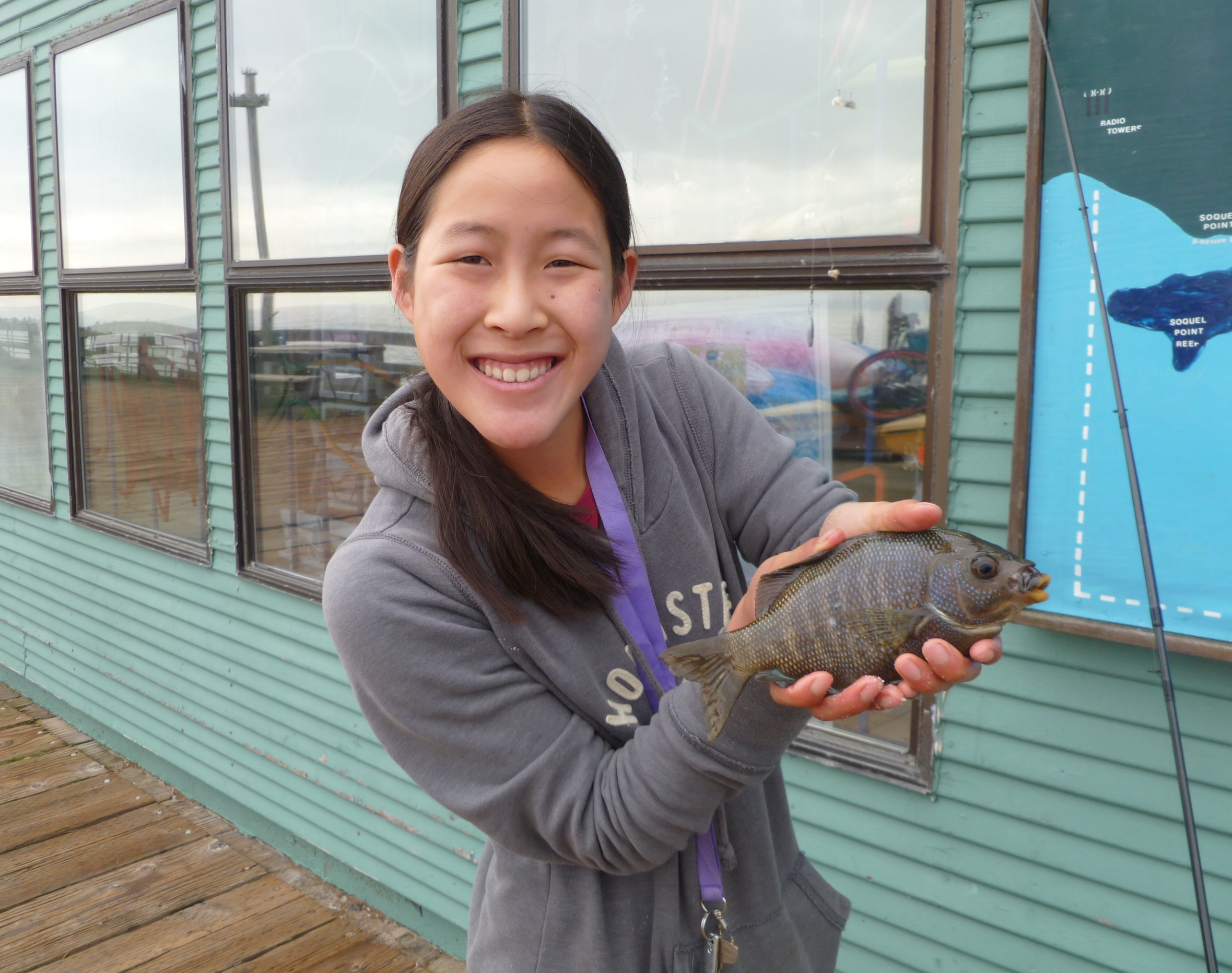
Blackperch — Picture courtesy of Capitola Pier Bait and Tackle
A few additional fish will also be landed under the pier by the pilings. These include cabezon, an occasional lingcod (to ten pounds), and a variety of rockfish including brown, grass, kelp, gopher and blue rockfish. Although some juvenile bocaccio may also show up be sure to release them. I did see a giant kelpfish landed one day on a multi-hook bait rig but it was sort of a contradiction in terms as the “giant” was only about five inches long. Remember to fish as close to the pilings as possible, especially pilings that show some kelp by them. If you prefer artificials, try using grubs (especially white or lime colored); they sometimes out produce the bait.

Kelp Greenling — Picture courtesy of Capitola Pier Bait and Tackle
Many anglers, especially those uninitiated to pier fishing, automatically head out to the end and cast out into the deeper waters. Here that is usually OK since there is usually a plethora of smaller species available most of the year—kingfish (actually white croaker and numerically the number one fish at the pier), bullheads (actually staghorn sculpin), small speckled sanddabs, and baitfish—sardines, herring, mackerel, jack mackerel and jacksmelt.

American Shad — Picture courtesy of Capitola Pier Bait and Tackle
For the kingfish, use cut anchovy, or small strips of squid on size 4 hooks, fish on the bottom, and cast out from almost any area of the pier. This has always been one of the top piers in the state for white croaker; in fact, I’ve only experienced one trip to the pier when I failed to catch a kingfish. It should be noted however that the size of the kingfish has seemed to decrease over the past decade. Some anglers now routinely keep small kingfish that never would have been kept in the past. Come on, let them grow up!

Angel Shark — Picture courtesy of Capitola Pier Bait and Tackle
The end area is also usually the area for sharks or rays; use squid and a fairly heavy saltwater outfit. Summer and fall seem the best times for sand sharks (brown smoothhound sharks), leopard sharks, bat rays, and skates. A 50-pound angel shark was caught and released in July of ’99, a 90-pound bat ray was caught in April of ’98, and a big skate weighing 130 pounds was caught a few years ago. Wintertime sometimes seems to be good for dog sharks (spiny dogfish), hornback sharks (horn sharks), and the smaller baby bat rays. Be sure if you are fishing for the larger game to come prepared with either a net (preferred) or a treble-hook gaff to bring the fish up onto the pier. Also, more and more anglers are practicing catch and release. One day I witnessed a young angler land a small Pacific angel shark. After a quick picture, the toothsome creature was gently lowered back down to the water to the applause of interested onlookers.
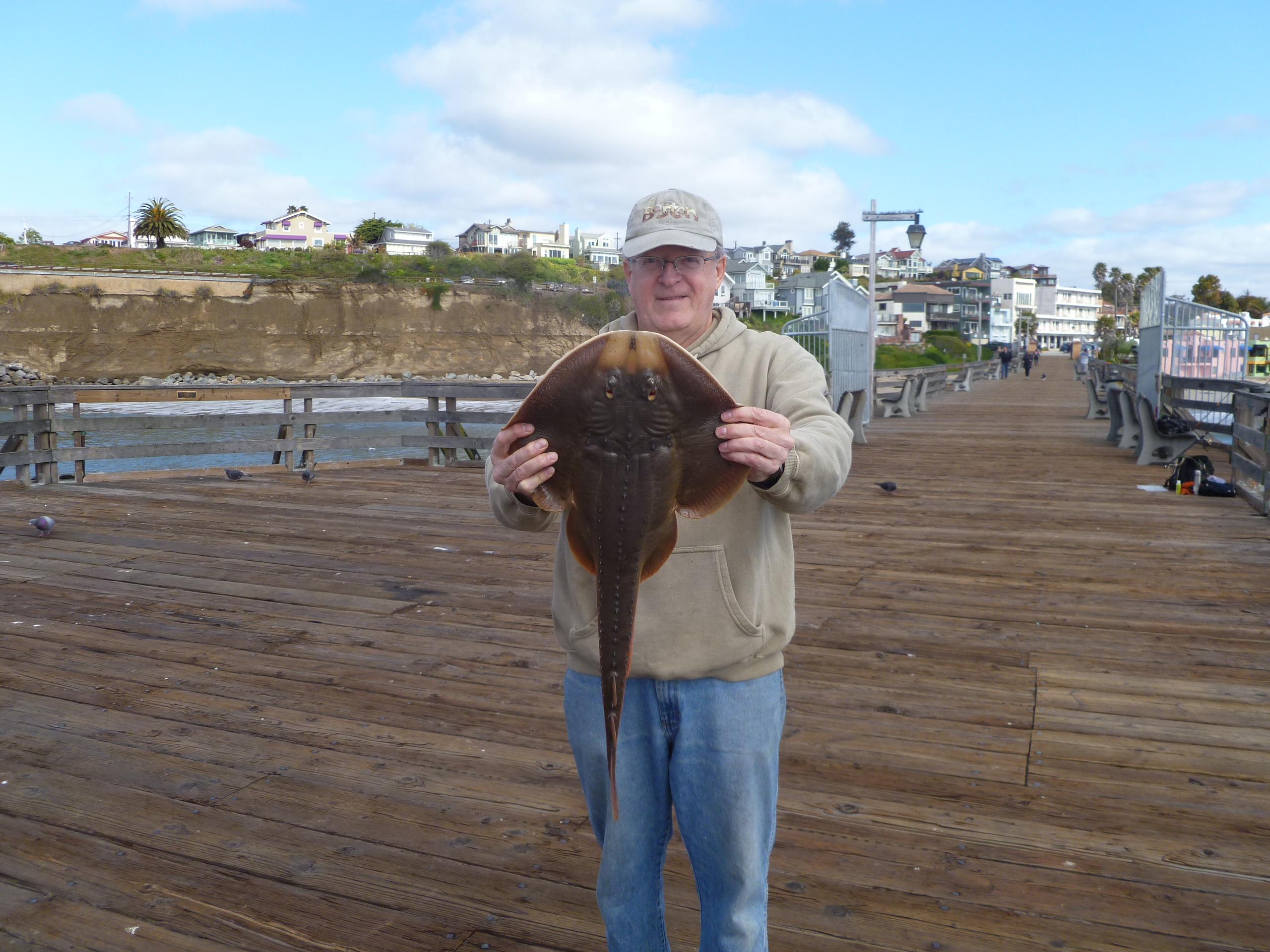
Thornback Ray — Picture courtesy of Capitola Pier Bait and Tackle
Additional species of sharays reported from the pier include thornback rays, shovelnose guitarfish, blue sharks and thresher sharks but they’re not a common species. In July of 2004 a longnose skate was reported from the wharf that may have been a California skate; who knows for sure?
Late spring through the fall are also times when Pacific mackerel, jack mackerel, sardines and a few white seabass may be in local waters. Most mackerel, jack mackerel and sardines will be caught on multi-hook bait riggings fished at mid-depth or fished near the top with the assistance of a large bobber or Styrofoam float. Jacksmelt can also be caught on these multi-hook riggings but often a few size 8 hooks on a line, baited with small pieces of pile worms, or small strips of squid, will be just as productive. Pacific herring tend to show up in the spring and most will be taken on bait rigs retrieved through the water.
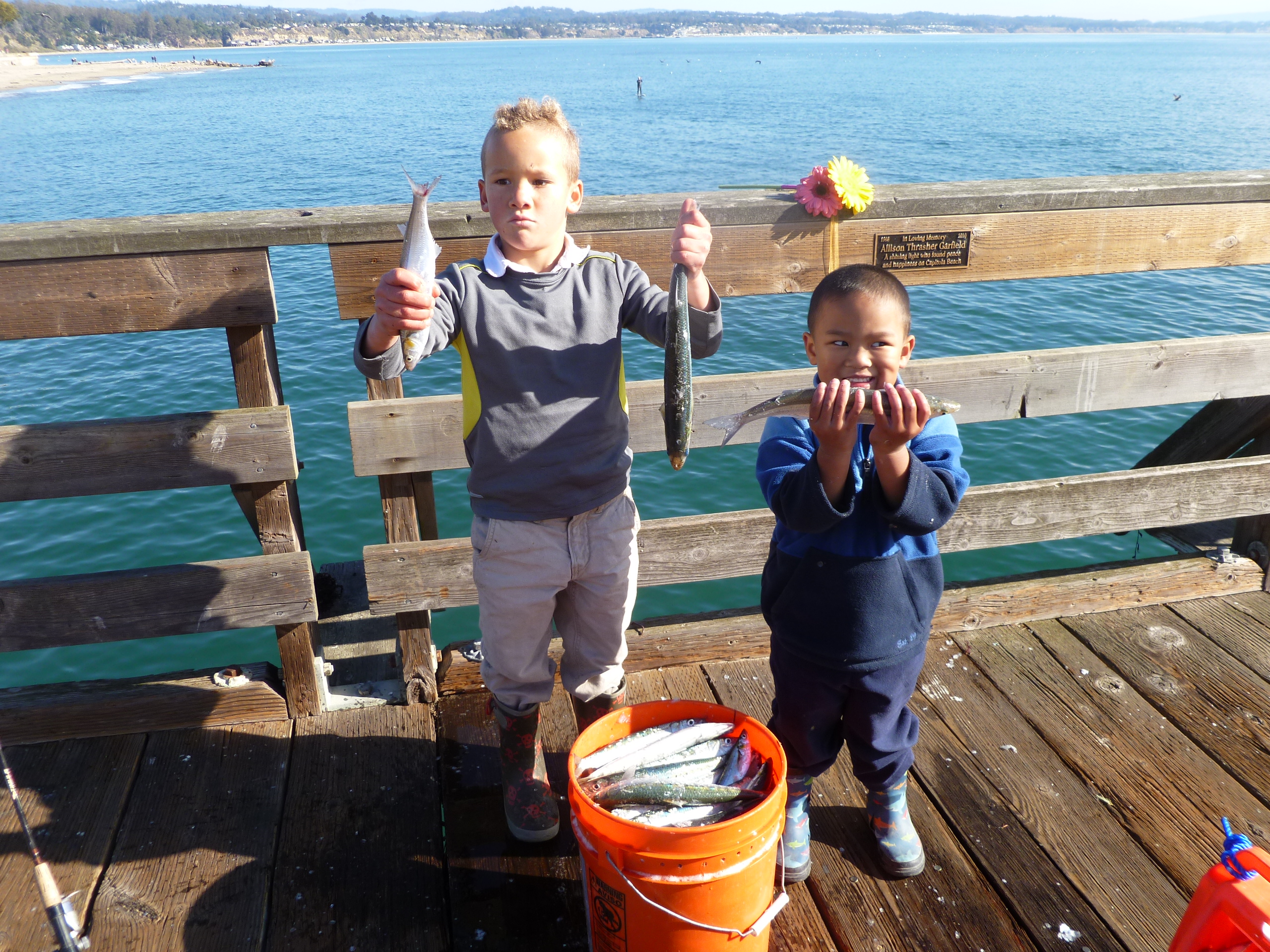
Jacksmelt — Picture courtesy of Capitola Pier Bait and Tackle
Although I’ve yet to see a white seabass taken during my visits to the pier, the fish are reported from the pier each year. The largest was a monster 45-pound white seabass taken in September of 2000. Local expert Ed Burrell caught a 28-pound white seabass from the wharf in September of 2004. If you want to give the large fish a try, use live bait and fish the early morning or twilight hours. Do remember to return any small, illegal white seabass (called seatrout) to the water. Of course there have been few days like the following:
Saltwater Report — Despite the big salmon news, the Capitola area may actually be the hot spot for this week. Ed Burrell from Capitola Boat and Bait calls it “wide open” As of Wednesday, a huge school of bait was pushed up to the shoreline, followed by a good variety of predators. “I’ve seen 25 white sea bass caught from the wharf today, caught with live anchovies or swim baits,” Burrell said. “Most were undersized, but at least four were legal.” If that’s not enough, Burrell helped net a legal halibut off the wharf and a 25-pound striped bass caught by Larry Roland.
—Allen Bushnell, Fish Rap, Santa Cruz Sentinel, June 14, 2007

Striped Bass — Picture courtesy of Capitola Pier Bait and Tackle
Salmon are an occasional catch most years while steelhead show up almost every year. Most salmon will be landed April through July on anchovies (fished under a float) or lures out in the deeper waters of the pier. Most of the salmon are king salmon that range up to about 20 pounds in size, most but not all. A 16-pound silver was taken in June of 2003, one day after the same angler had caught a 13 1/4-pound king salmon from the wharf. A 6-pound silver salmon was caught (and released) in December of 2007; it was caught on a Little Cleo lure. (Remember that silver salmon are now illegal to keep.)

Silver Salmon —Picture courtesy of Capitola Pier Bait and Tackle
Most steelhead are landed during the late fall to winter months although a few may show up in the spring depending upon the year’s rain patterns. Many of the steelhead are caught on live bait (anchovies, if available), but pile worms, night crawlers, frozen anchovies, strips of squid and lures take a considerable number (Roostertails and Krocodiles seem to be the preferred lure of the local experts although some have also been taken on simple Sabiki rigs). The steelhead, some small 12-14–inch fish, but commonly up to about six pounds in size, often like to school in the fairly shallow, mid-pier waters on the north side of the pier. A nine-pound steelhead was reported in October of 2003.

Steelhead — Picture courtesy of Capitola Pier Bait and Tackle
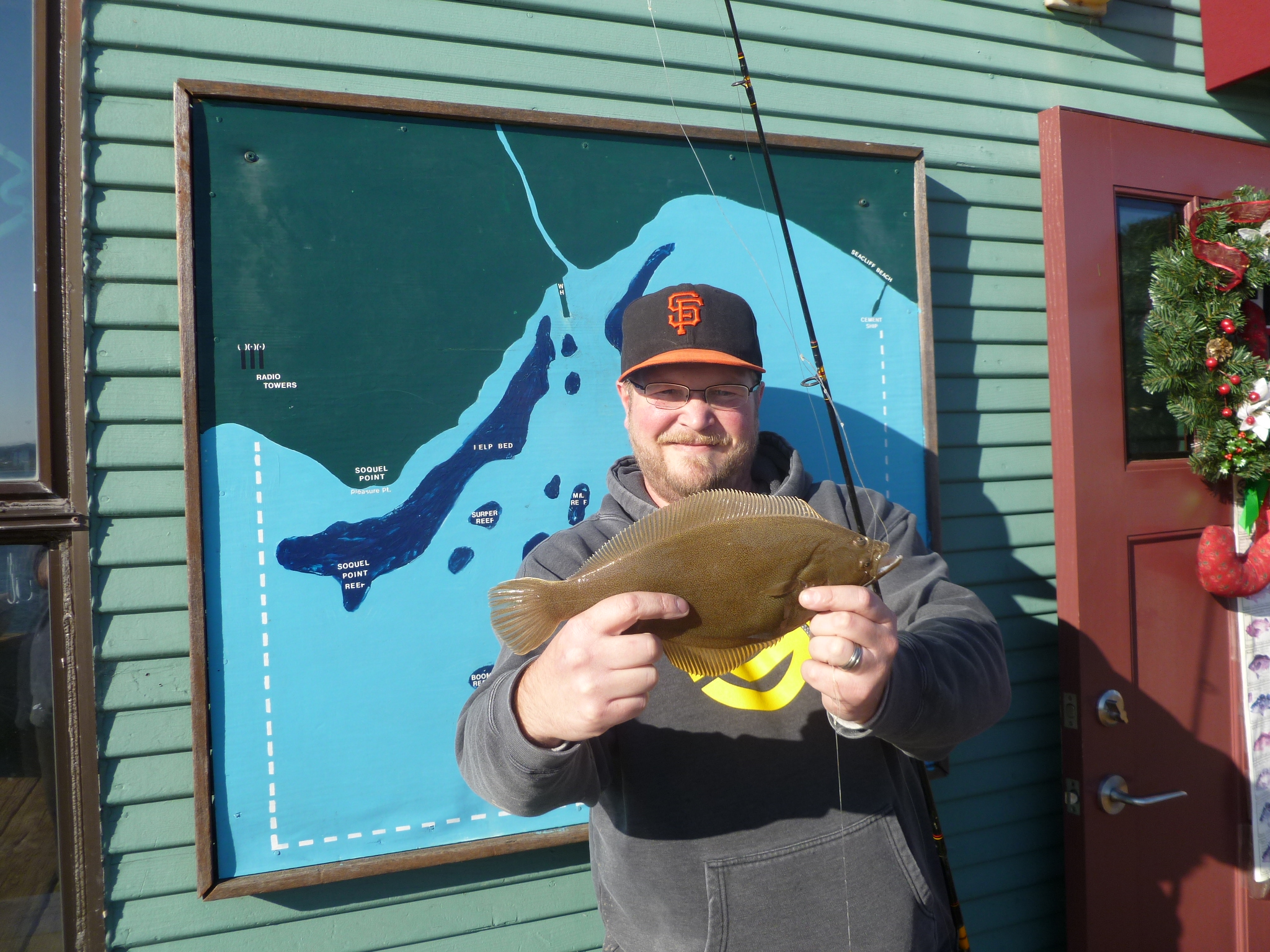
Sand Sole — Picture courtesy of Capitola Pier Bait and Tackle
As mentioned, staghorn sculpin (bullheads) are common. In fact, they are too common. I had one trip here where I stopped fishing simply because I couldn’t keep them off my line. Although these sculpin are notorious for hitting hooks on the bottom baited with pile worms, that day they seemed to hit any bait and hit it not only on the bottom but at mid-depth. I tried artificial lures for a while but when a sculpin finally hit one of those, I decided it was time to move on. It’s easy to see why one local calls them the vermin of the sea!

Starry Flounder — Picture courtesy of Capitola Pier Bait and Tackle
Crustaceans, etc. Crabbing is also practiced at the wharf although I do not believe it is as productive as down the road at the Santa Cruz Wharf. Nevertheless, several species including Dungeness, slender crabs, rock crabs and spider crabs are taken down by the pilings.
September 2008 saw anglers landing small squid on Sabiki bait rigs. If you’re a newbie to the pier, and in doubt, consult the folks at the bait and tackle shop on the pier, they’re knowledgeable and ready to help an angler.

Crab
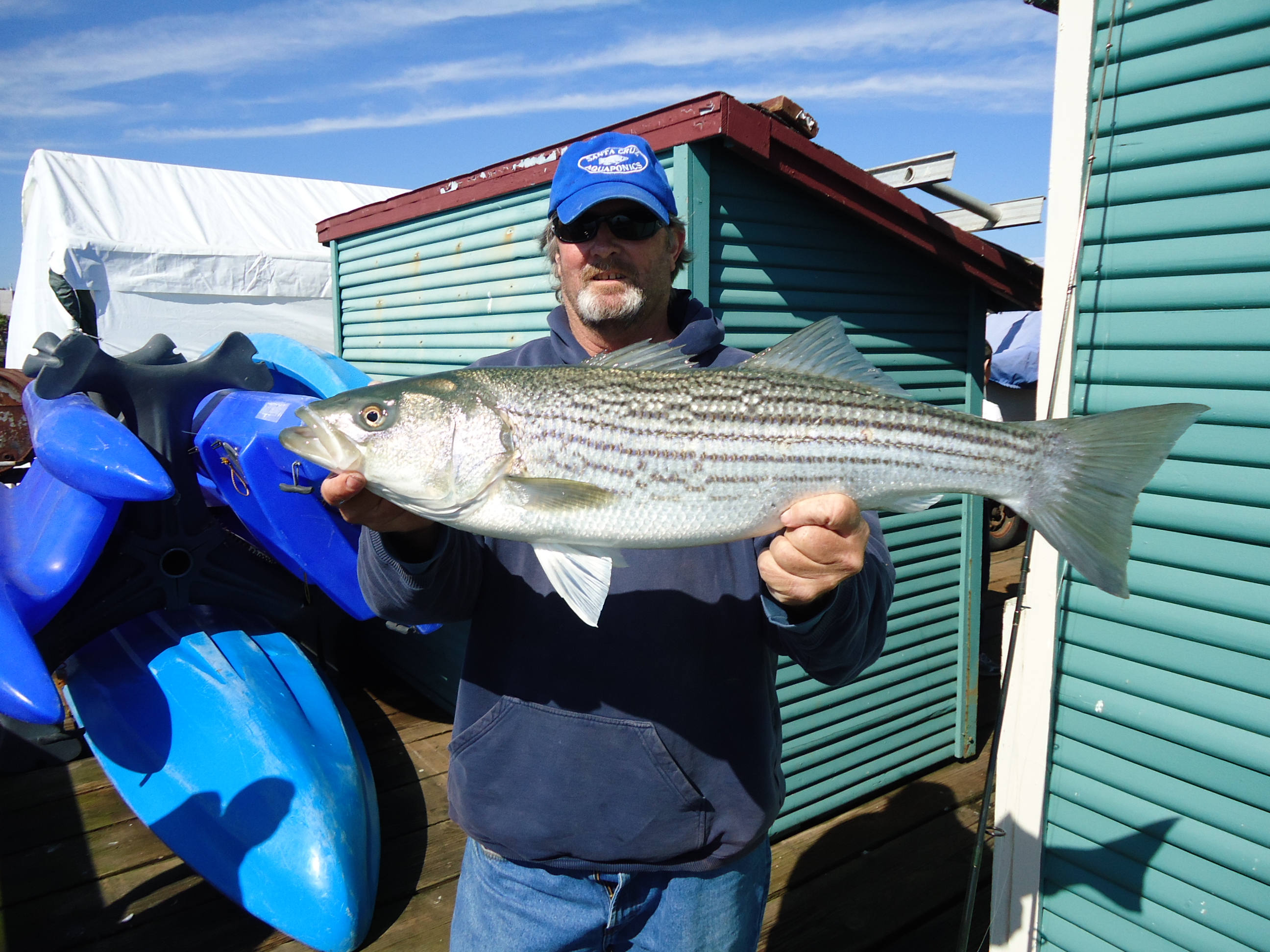
Striped Bass — Picture courtesy of Capitola Pier Bait and Tackle
The Pier Rats Speak
Date: September 1, 2000; To: Pier Fishing in California Message Board; From: Ken Jones; Subject: Capitola Wharf
Ed, at the Capitola Boat and Bait Shop (on the wharf), reports that some stripers are still being taken from the wharf and they’re reaching good size (including fish up to 25 pounds last week). Not a lot of them but enough to keep it interesting. He says there is a lot of bait in the water (sardines and anchovies) and most of the big fish are falling to live bait that has been taken on bait rigs. It’s slow on kingfish (white croaker) but some halibut are also showing at the pier. Unfortunately most are too short to keep. Quite a few perch are also available but they are small-sized perch – walleys and shiners. Shark fishing has been slow with only a couple of leopard sharks being taken. Most interesting are the reports of barracuda close in near the pier although none have been caught at the pier so far.

Striped Bass —
Date: October 1, 2000; To: Pier Fishing in California Message Board; From: Ken Jones; Subject: Capitola Wharf
Ed at the Capitola Boat and Bait Shop (on the wharf), reports that a 45-pound white seabass was taken from the pier this month and that a few salmon have also been landed. He didn’t have much else news about the pier but that wasn’t bad.
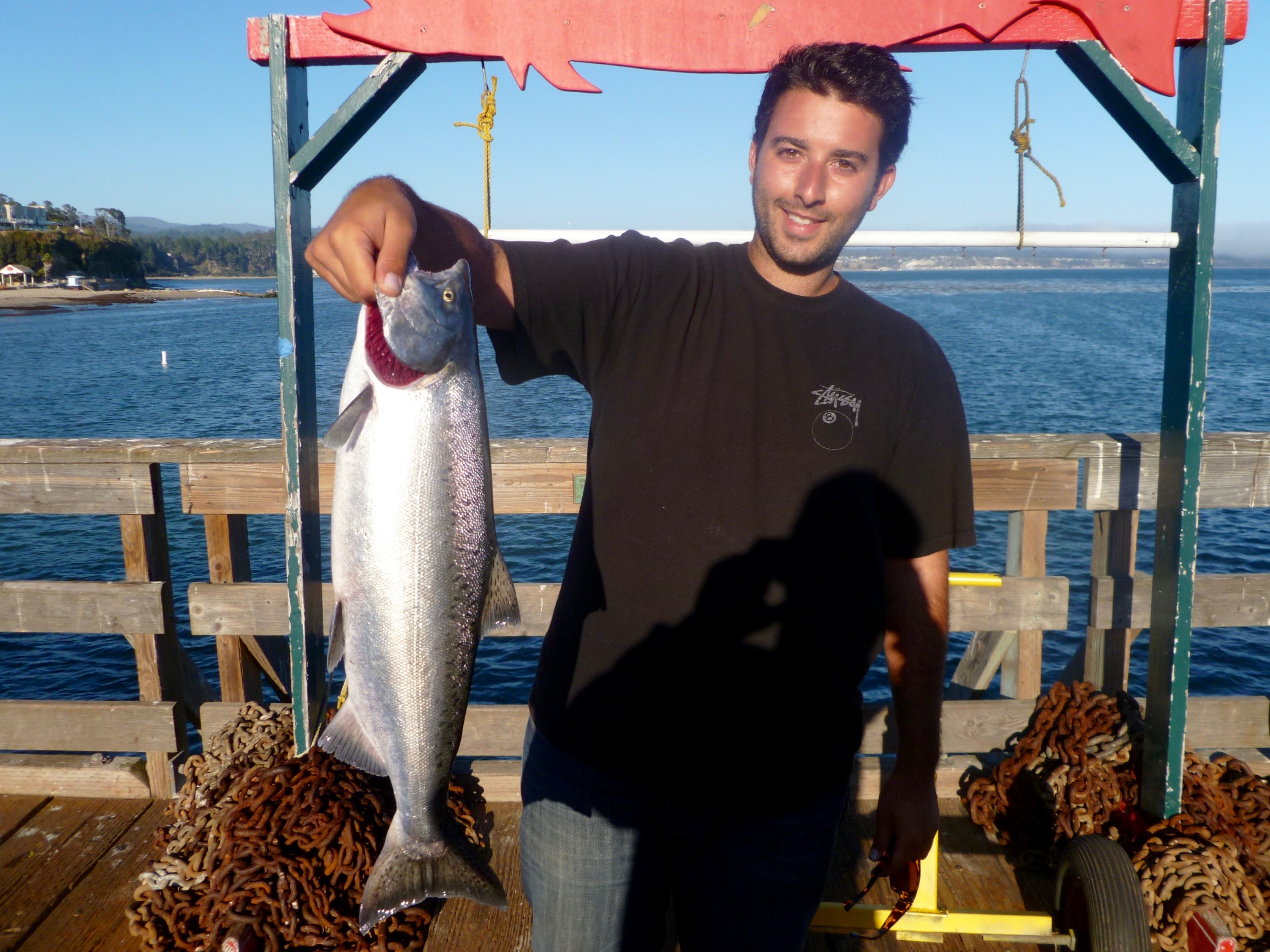
King Salmon — Picture courtesy of Capitola Pier Bait and Tackle
Date: February 25, 2002; To: PFIC Message Board; From: geckomd; Subject: Capitola Pier Report
Fished Capitola from about 9:30 to 12:30. Action was slow for us but perch were being caught by all of the regulars. They felt so sorry for us that they started giving us their catches!
All in all, it was a great day and the sea was glass-surfaced. Met a couple of the regulars…really nice old-timers, Harry and Dave to name a few, who gladly stopped their fishing to give us tips and the how-to’s and where-to’s to land these perch and other species to be found in the Capitola waters. Met Dan, Ed, and Anna from the bait shop. Really nice people with many photos of trophy fish caught in years past hanging on the walls, who also took the time to share with us their experiences and tips. Dan even invited us to follow him out in the boat to some of his favorite and productive spots.
Bait used was shrimp and motor-oil plastic grubs. However, according to these guardians of the pier, the secret was the green colored, chartreuse, plastic grubs. Apparently, if you were using the green grubs, you were sure to limit out on the perch. Can’t wait for those halibut to start coming in. Capitola, here we come!

Calico Surfperch — Picture courtesy of Capitola Pier Bait and Tackle
Date: March 22, 2002; To: PFIC Message Board; From: geckomd; Subject: Capitola Pier Report
Fished at Capitola Pier yesterday afternoon from 1:00 – 4:00PM. Non-stop perch action the entire time that we were there. When I left, they were still biting! The three of us averaged about one hook up every 2-3 minutes and this particular school had larger walleye perch with most fish in the 9-10+” range. Believe or not, my arms actually got tired from hauling those fish up the pier, unhooking them, and throwing them back. One of the customers in the restaurant, who was watching us do this for an hour, rushed home to get his gear just so he could join in on the fun! Best action to date! Enjoy!

Walleye Surfperch — Picture courtesy of Capitola Pier Bait and Tackle
Date: September 29, 2002; To: PFIC Message Board; From: Russ Johnson, Fat Rat; Subject: Capitola Pier Report
There’s been a fair amount of bait in the water, and people are catching halibut and even a few stripers off the pier. There was a 15-lb. striper on 9/16 and a 14-lb. striper on 9/21, but nothing reported since then. Someone caught a 7-lb. salmon on 9/18, and there was also a 10 lb-halibut caught on the 18th. These along with the numerous perch, kingfish, bullheads. All were caught using anchovies or sardines, most off the bottom with a slider rig of some sort. Although one guy told me he saw a big striper caught last weekend using a live anchovy about six feet below a bobber. The weather has fantastic all month. Yesterday was the first chilly day, but today was nice again. I fished Capitola for about three hours this morning, and caught five perch and a bunch of bullheads.”
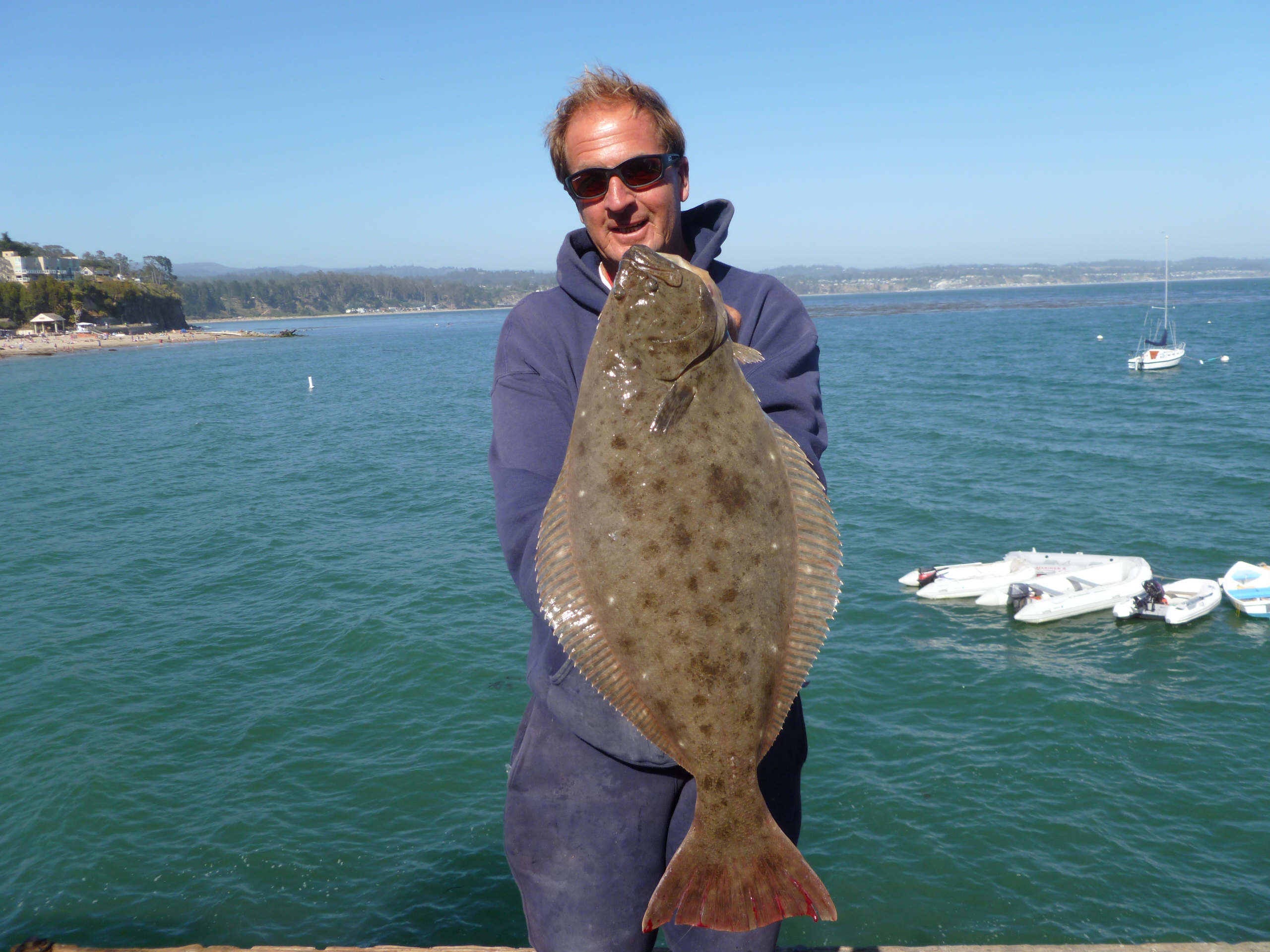
California Halibut — Picture courtesy of Capitola Pier Bait and Tackle
Date: June 19, 2003; To: PFIC Message Board; From: pescare; Subject: Capitola 6/19 – Stripers!
Not me of course, but the other guys… We fished from 3pm to 6pm this afternoon. Pretty good crowd on the pier and the sweet spot just inside the grey gates was a little crowded. I personally saw five stripers landed and heard of one more caught before we got there. Not a single halibut as of 6pm. All stripers were caught on live anchovies of which there were plenty to be caught as needed. The largest was about 17lbs and was hooked on the west/north side right next to the gate on a Carolina rig. The others were in the 7-8lb range and were caught with a mix of Carolina and float rigs. Only saw one picked up on the east/south side today.
I fished with my girls next to the gate on the east/south side and we were as busy and could be with walleye, shiners, anchovies and sardines on Sabiki rigs. I had a line out with live bait the whole time but got no good fish. I did have one bit of excitement when my bobber went under and headed toward shore. My heart was racing until I set the hook and felt that the fish was not a big one. I got it to the surface and just couldn’t believe it. A big fat jacksmelt of about 18″ somehow managed to get my live anchovy and #hook down its throat!
Highlight of the day was not the big fish though. We had been fishing next to a very nice gentleman and having a nice visit and sharing live bait with him. Later on he was joined by his wife who had their two grandchildren in tow, a girl of about 6 and a boy of about 8 years. I learned that neither of them had ever been fishing before so I Okayed it with my girls and lent the grandpa their two rods so the kids could give it a go. The little girl hooked a big walleye within about 15 seconds and just went nuts! She screamed and jumped around and was just loving it. That was followed up by the boy doing the same thing a couple of minutes later. Can’t really say if the kids had the bigger smiles or grandpa did, but it sure felt good to see it. The kids insisted they call their parents right away and grandma got on the cell and made the connection so they could share the excitement. I feel like we made some friends for life even though we’ll likely never see them again.
Oh, that 36 fish day I heard about…. Never happened. I talked to Ed at the boat rental about it and he said no way. There were 6 caught on the wharf that day if I remember correctly, and about 12 from skiffs. There was a 14-lb salmon caught from the wharf yesterday too. Great day out there. I’m still buzzing over all the cool stuff. Ed
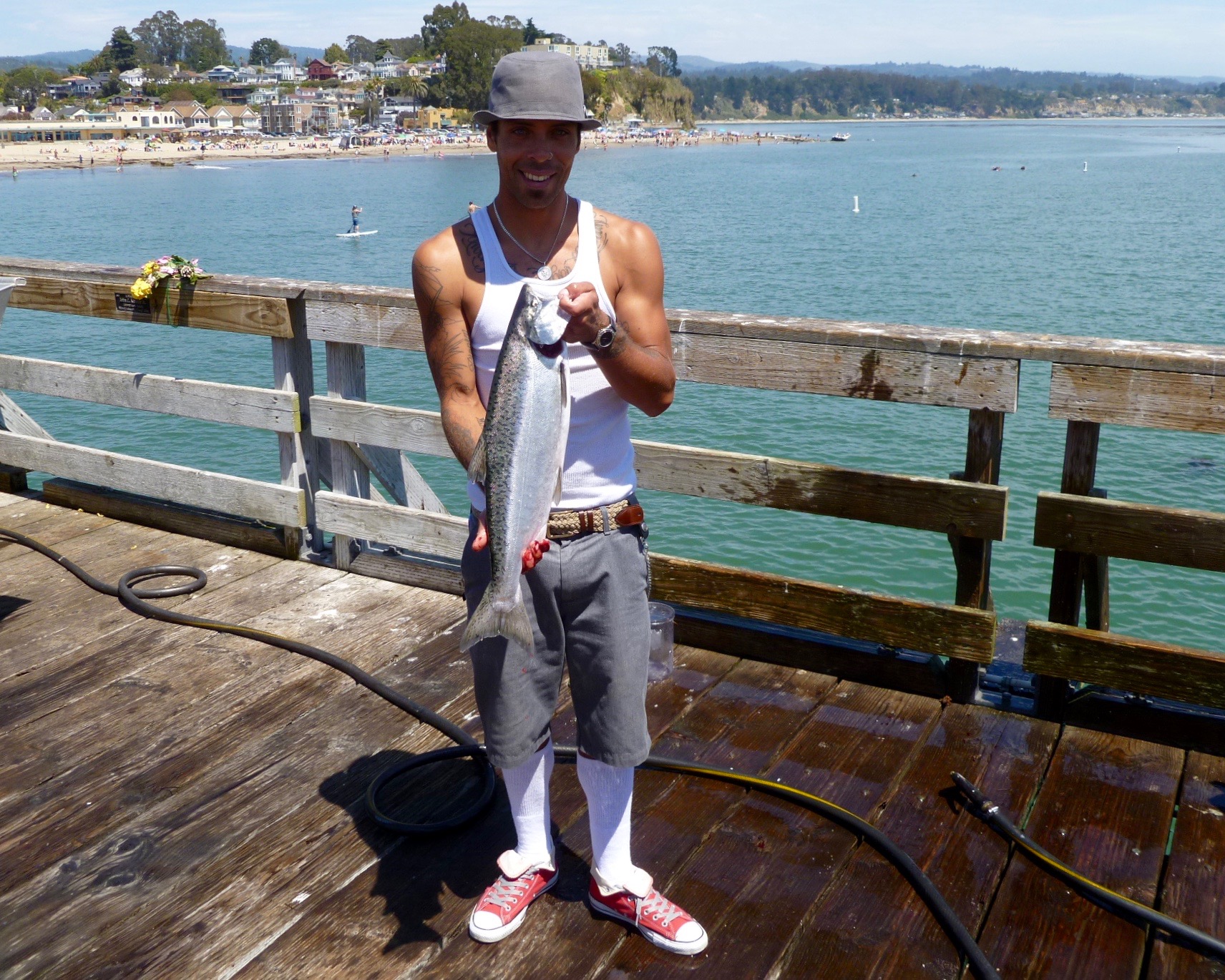
King Salmon — Picture courtesy of Capitola Pier Bait and Tackle
Date: November 17, 2004; To: PFIC Message Board; From: FakeFisherman; Subject: Capitola Pier Report
After poking around the archives for some new piers to check out, I decided to head down to Capitola with a friend to check out the wharf. We missed the incoming tide, unfortunately, but it was a quick drive down from Palo Alto. Got there at around the top of the tide and fished the surf for a while. It was a really beautiful day.
Threw out some mussels and ghost shrimp and got some taps and finally reeled in a silver surfperch (released) on the mussels. There were lots of very large pileperch feeding around the pilings. One guy was trying to snag some, but no luck. Not much else happened so we moved out towards the end and threw out some squid and anchovies. My friend brought in a smallish kingfish, her first, and then her first baby bat ray. As the sun started to go down we nailed kingfish after kingfish, but they were TINY. Gave a couple of the decent-sized ones to a cool Jamaican dude (a regular there, I think) that was also fishing there. Thought about using some as bait but didn’t think there was anything other than the babies that would be biting. The fog and cold rolled in around 6:30 so we headed out.
Total: 1 – silver surfperch — 1 – baby bat ray — 2 – kingfish — 18 – micro kingfish — 3 – bullheads — 1 – micro sanddab
This was a really nice pier and relaxing day out. If it weren’t for PFIC I wouldn’t have known to check it out!
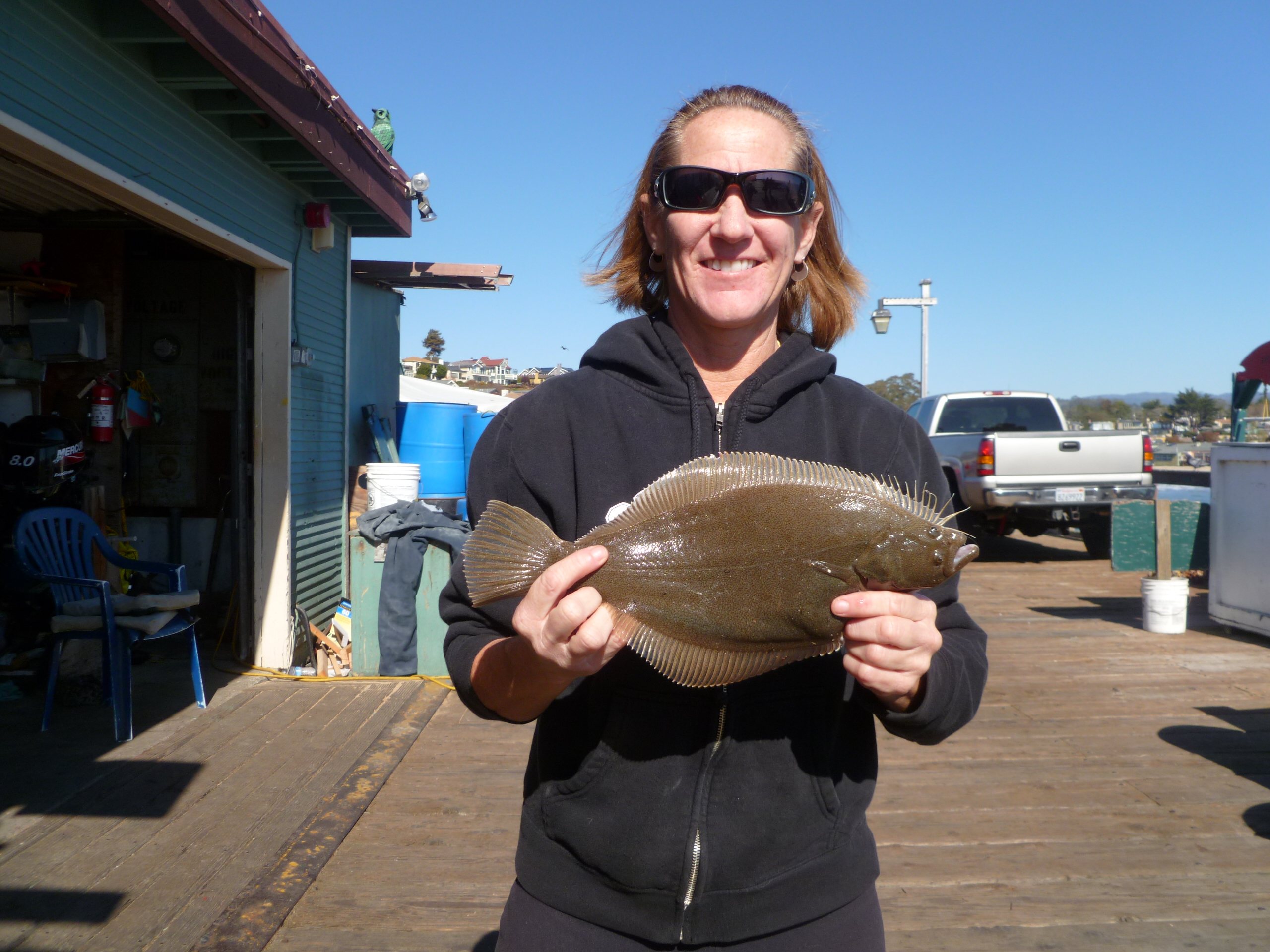
Sand Sole — Picture courtesy of Capitola Pier Bait and Tackle
Date: June 14, 2007; To: PFIC Message Board; From: tenaciousD; Subject: White seabass at Capitola
I just got back from the pier literally 2 minutes ago. The bite was still hot, but not for white seabass. Stripers were hitting live anchovies really hard, but unfortunately not swimbaits or topwaters. I was there for 1.5 hrs throwing out a Big Hammer bait fish color 6” swimbait w/ 3/4oz head. One good tap on my 3rd cast out that nearly took my swimbait off, but nothing after that. In my short time on the wharf, four stripers were landed, two seemingly over the 10-lb. mark, and all looked like keepers. The bite seemed to have died down in the last 15-20 min that I was there, but I’m sure it was only temporary.
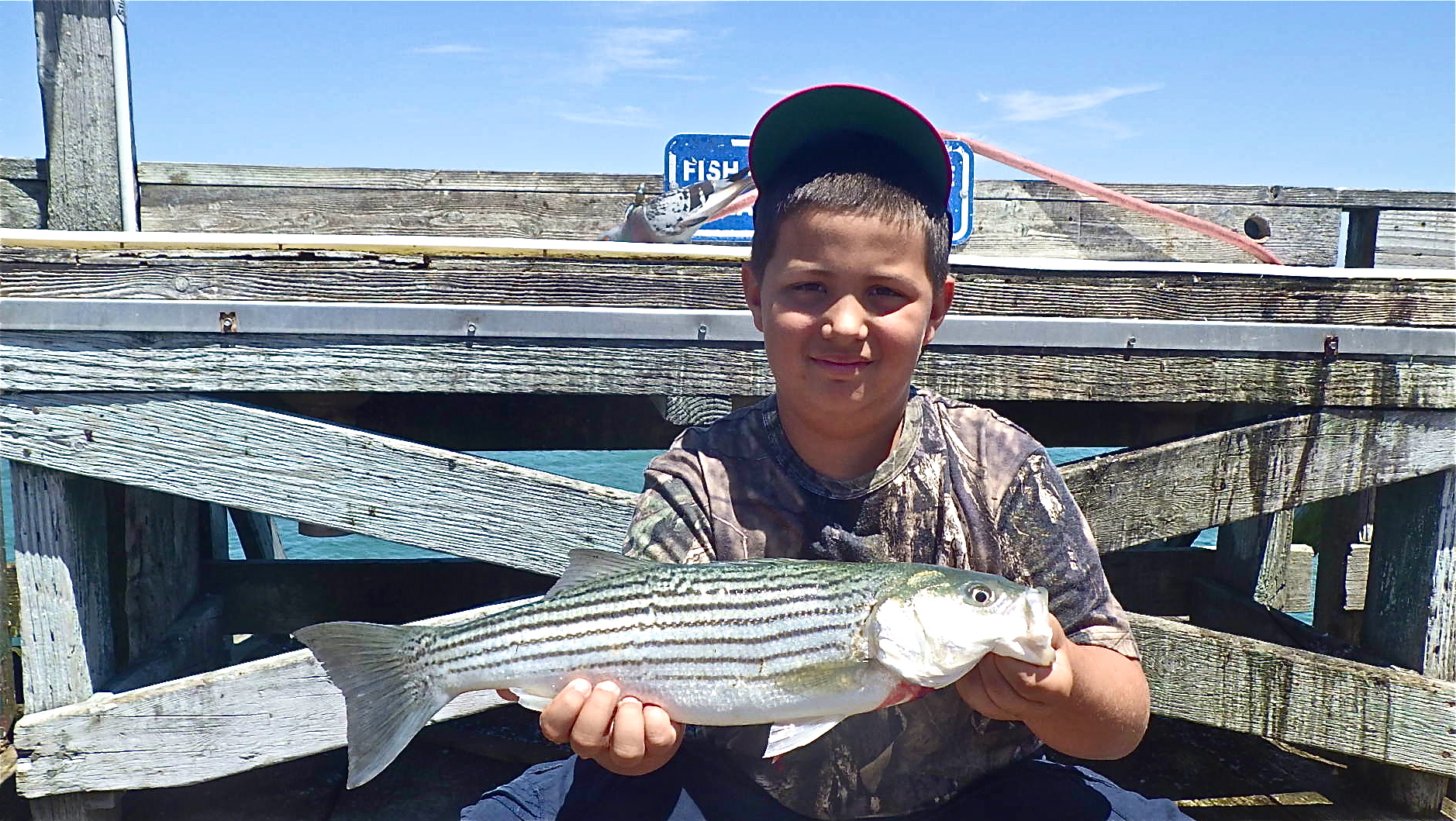
Striped Bass — Picture courtesy of Capitola Pier Bait and Tackle
Potpourri — Possibly More Than You Want To Know About The Capitola Wharf
<*}}}}}}}}}>< — Fish and Game fish surveys done from 2004-2009 showed 26 different species as follows (numerically) — northern anchovy, white croaker, jacksmelt, barred surfperch, shiner perch, walleye surfperch, calico surfperch, topsmelt, silver surfperch, black perch, brown rockfish, pile perch, Pacific mackerel, white seaperch, Pacific sardine, blue rockfish, Pacific sanddab, staghorn sculpin, leopard shark, sand sole, rock sole, starry flounder, gopher rockfish, grass rockfish, vermilion rockfish, thornback ray. Surprisingly no striped bass or halibut were recorded even though many were caught.
<*}}}}}}}}}>< — You just never know!
Fish Rap — Saltwater Report
Big fish honors this week go to angler Larry Roland. While soaking a 7-inch smelt off the Capitola Wharf last week, Roland hooked a rare giant black sea bass. The barrel-shaped beauty, estimated to weigh around 40 pounds, provided a lively 15-minute fight fro Roland. Ed Burrell provided a timely assist from Capitola Boat and Bait, using his shore boat to net the fish. A quick picture was taken, and the fish was successfully released.
—Allen Bushnell, Fish Rap, Santa Cruz Sentinel, September 14, 2006

<*}}}}}}}}}>< — Capitola Boat & Bait is located mid-pier and is one of the best-run pier tackle shops that I have seen and deserves congratulations for a job well done. A full line of fresh and frozen baits are available as is tackle, rod and reel rentals, crab nets, snacks and drinks, and a wide variety of odds and ends catering to both anglers and non-anglers. Boats, of course, can be rented and pictures of the catches are pretty impressive. Of note is that live anchovies are available some summers. This is one of the few remaining piers in California that (sometimes) offers live anchovies (and the only pier in northern California). The shop even offers free pier fishing seminars (“Learn to Fish Off the Wharf”). Perhaps most impressive to me is the professionalism of every employee that I have met. By the way, one of the pier’s most unusual catches of recent years was made when Frank Ealy, owner of the bait shop, decided to drift a live Spanish mackerel (jack mackerel) from the pier in early September of ’98. He was rewarded for his efforts with a 40-pound giant (black) seabass that was gently returned to the water. Shortly thereafter, Ed Burrell, one of Ealy’s employees, was drifting a live Pacific mackerel off the (Seacliff Pier) Cement Ship in 32 feet of water when he hooked and landed a nearly identical fish. A third giant (black) sea bass, was caught from the wharf in September of 2006. The fish was taken on a live jacksmelt and 12-pound test line and weighed, like the first two, 40 pounds. It was netted, weighed, and released back into the water.

Giant Kelpfish
<*}}}}}}}}}>< — In the DF&G Fish Bulletin 130, Miller and Gotshell reported that the pier was the farthest north location where queenfish, Seriphus politus, were recorded during their Oregon to Point Arguello survey, with “several taken in 1963 at Capitola pier.”
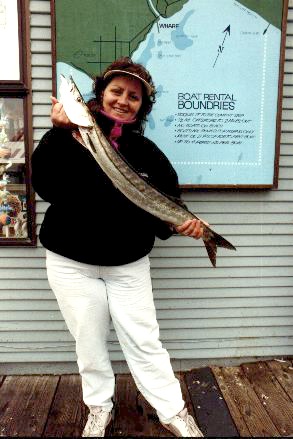
Barracuda caught in 1997
<*}}}}}}}}}>< — Although the pier is not a noted place to catch sharks, quite a few nice-sized Selachians have been taken over the years. I’ve never heard of a salmon shark being taken from the wharf but apparently they are in these waters.
Scientists Puzzled Over Dead Salmon Sharks
Nearly a dozen dead juvenile salmon sharks, disoriented by brain infections and often mistaken for baby great whites, have washed up along Central Coast shores in the past month. And it’s not the first time, although it’s the greatest number in recent memory, researchers say…
Every summer for the past decade, dead baby salmon sharks have inexplicably beached themselves, an uncommon occurrence because sharks tend to sink to the bottom of the ocean when they die.
Necropsies conducted at Stanford University and Long Marine Lab at UC Santa Cruz have shown that most of the salmon sharks had bacteria-induced brain infections at the time of their deaths, but shark experts still don’t know the source of the bacteria.
Even more baffling are the salmon sharks themselves, which are rarely spotted alive in the waters of the Central Coast but whose numbers are legion in the Gulf of Alaska – so much so that they’ve been referred to as the “poor man’s marlin” among fishermen whose livelihoods hinge on catching them.
“There’s a mystery in the Monterey Bay and the mystery is that something that looks like a baby white shark dies on our shores every year,” said Dave Casper, a veterinarian with Long Marine Lab at UC Santa Cruz. “And yet we never catch live salmon sharks in the bay. But we know they have to be there if they’re washing up on our shores.”… The deep waters off the Central Coast serve as an annual “pupping grounds” for the adult female sharks, who each year migrate from as far north as Prince William Sound in Alaska to as far south as Southern California waters, said Sean Van Sommeran, executive director of the Santa Cruz-based Pelagic Shark Research Foundation.
Van Sommeran and his foundation have been busy lately, collecting the vast majority of dead sharks after they’ve been discovered, whether near the Capitola Wharf, as was the case a few weeks ago, or just outside Half Moon Bay, the most recent find two days ago.
—Tom Ragan, San Jose Mercury News

Dogfish — Picture courtesy of Capitola Pier Bait and Tackle
<*}}}}}}}}}>< — Every summer the shearwaters (Sooty, Short-tailed, Pink-footed, and Buller’s) descend on the waters of Monterey Bay, especially the waters between Santa Cruz, Capitola and Seacliff. It’s part of their annual trip that takes them from Australia, New Zealand and Tasmania up to Japan and Asia, across to Alaska and down the coast to California before heading back across the ocean. Their numbers have been estimated to reach two million in the local waters and their behavior led to the creation of a fairly famous movie. Several decades ago they seemed to drop out of the sky on Capitola, a story reported by the Santa Cruz Sentinel. Alfred Hitchcock, who vacationed in Santa Cruz, saw the story and sent a clipping to Hollywood where it was turned into the script for a movie—The Birds.

Barred Surfperch — Picture courtesy of Capitola Pier Bait and Tackle
<*}}}}}}}}}>< — Like many beach towns in California, parking in Capitola, especially in the small area near the beach, is almost always gnarly. During the summer tourist season, and/or weekends, it can not only be gnarly but nightmarish. There is metered parking on the streets but it is limited to two hours and gone quickly. City parking lots are available but they’re expensive. That’s why the city runs shuttle buses from more distant parking lots to the beach most weekends.
The best way to alleviate this problem is to arrive early in the day when the pier is first opening up. Generally there will be some parking spaces available up the hill on Cliff Drive (a fairly short walk to the wharf). The spaces are also metered but provide longer times for parking. However, later in the day even those spaces may be gone. Fish early or fish late (although the restaurants and bars stay open late so even evening hours may be crowded). Nevertheless, anglers do find parking, do find their way to the pier, and they do catch fish.
However, there is one time you probably should just forget visiting the wharf. That time is during the annual “Wharf to Wharf Race” that starts at the Santa Cruz Wharf and winds up at the Capitola Wharf. It is held on the fourth Sunday in July and “limited” to 15,000 runners. The race, started in 1973, is one of the biggest local events and a lot of fun but simply clogs the entire infrastructure around Capitola’s Wharf. I guess you could come “really, really early” and stay “really, really late” but for myself, I’ll pick a day when the road is less traveled.

Starry Flounder Hybrid — Picture courtesy of Capitola Pier Bait and Tackle
<*}}}}}}}}}>< — You never know what you’re going to see on piers and an October visit in 2013 proved that thought true. My friend Hashem and I were fishing out at the end of the wharf when a group of about ten people, some adults and some youngsters, showed up hauling a big wooden ramp out to the end. Luckily no one was in the exact spot where they wanted the ramp to sit or there might have been a problem. Their goal as it turned out was to bicycle off the ramp and into the sea. The fact that the activity might not exactly be good for the fishermen, and there were several people fishing, did not seem to be a concern. A crowd gathered, divers went into the water, and people readied their cameras. We never saw the conclusion because we were scheduled to be in Santa Cruz and had to leave. Was it a commercial for a shop, something for YouTube, or just an exercise for the group? We never found out nor did we find out if they had a permit to take over the end of the pier for their plunge.

Juvenile Sablefish (a deepwater fish) — Picture courtesy of Capitola Pier Bait and Tackle
History Note. The name Capitola is Spanish for capital and was apparently first used by F.H. Hihn of Santa Cruz when he laid out a new resort in the area in 1869. The good residents of Soquel had offered to let the State of California establish its capital in the upstairs rooms of Ned Porter’s local store but California politicians (wisely) declined the offer. Hihn used that information when he named the site; it had been called La Playa de Soquel, the beach of Soquel, during Mexican rule, and Soquel Landing under American rule.
Apparently Soquel Landing had a small pier prior to 1857 but Hihn and the Pacific Coast Steamship Company started a new wharf that year. In 1860, it was lengthened to 1,100 feet (some reports say it was lengthened to 1,200 feet in 1863) but a storm in November of 1865 destroyed the outer 500 feet of the wharf and made the inshore part of the pier unsafe. The steamship company soon rebuilt the pier. The beach itself became a favorite of vacationers from San Francisco, brought initially by horse-drawn vehicles, and then, after 1876, by the Santa Cruz-Watsonville narrow gauge railroad whose depot sat on Soquel Landing road, a short distance up the road from the wharf. However, the railroads began to take business away from the shipping line and the wharf was abandoned in 1879.
Soquel—Located on the bank of Arroyo Soquel, four miles east of Santa Cruz and one mile north of Capitola. It is therefore one mile from the bay or Soquel Cove. The name is that of an Indian village. The area about the mouth of Soquel Creek (where Capitola now is located) was formerly known as Soquel… A surveyor’s map of the place in 1858 shows a wharf on the bay, a dam in the stream and a millsite, which became in succession a flour mill, a sawmill, a paper mill and a tannery… By 1888 there were 10 fishing boats operating out of this place which ranked second as a fishing port of Santa Cruz County. By this time the Southern Pacific railroad had been built and Soquel was a favorite spot for rail shipments of fish. Modern maps show the railroad passing through Capitola, not through Soquel.
—W. L. Scofield, Fish Bulletin No. 96, California Fishing Ports, State of California Department of Fish and Game, 1954
As mentioned, the pier has been damaged many times. In fact, I have a picture, dated 1913, which shows the wharf split in half (as a result of a 1912 storm); the picture is remarkably similar to one I took in the mid-’80s following the storm of 1983. In 1998 the wharf was closed for about a month following winter storms. The next year saw more than $1 million in renovations and a closure that lasted several months; it officially reopened for the July 4, 1999 weekend. However, the wharf was closed again for repairs in February-March of 2000.
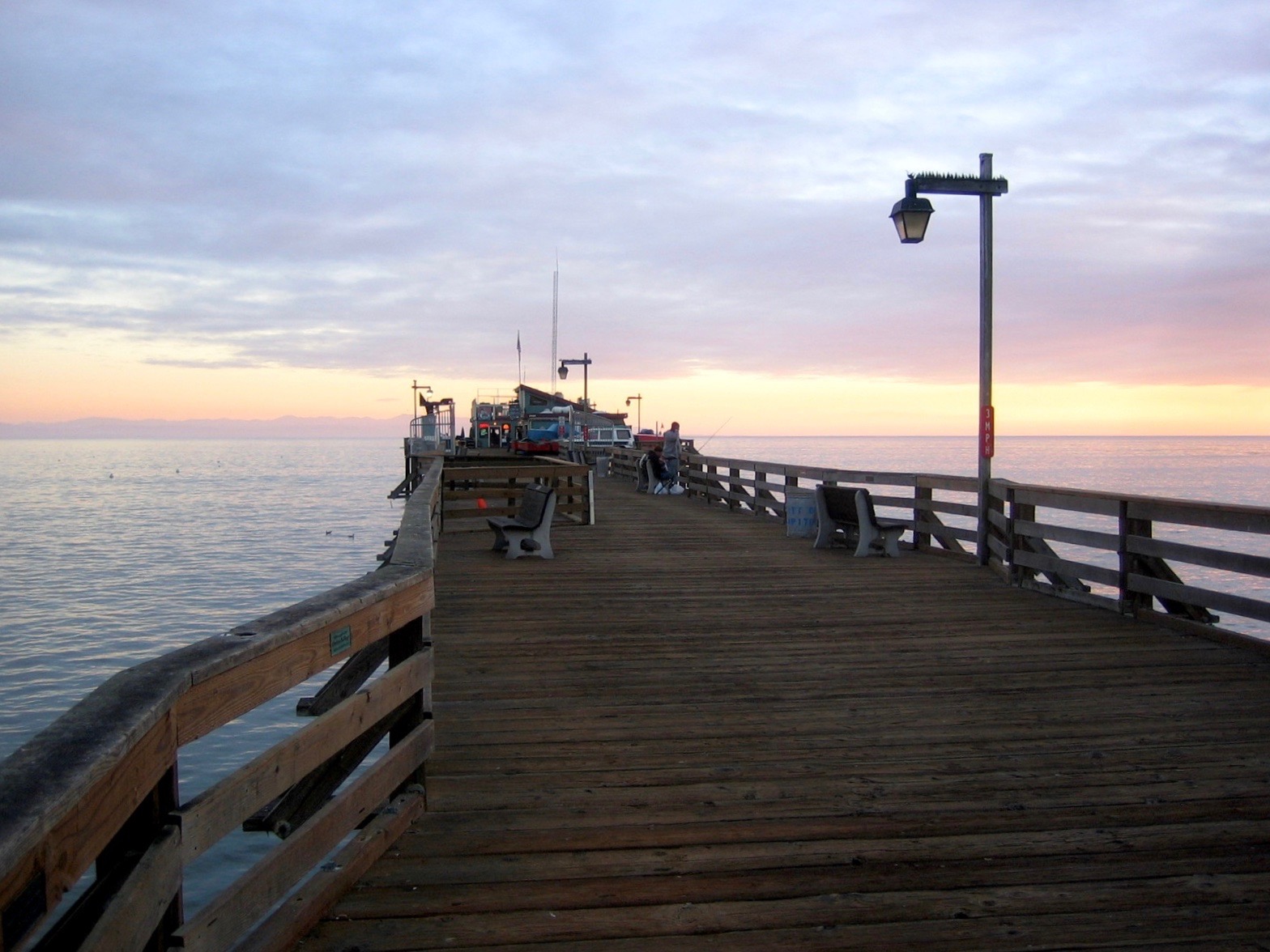
Capitola Wharf Facts
Hours: Open from sunrise to 10:30 P.M.
Facilities: Fish cleaning stations, restrooms, benches, lights, the Wharf House Restaurant and the Capitola Boat and Bait Shop are located on the pier. Parking can be found just up the hill on East Cliff Drive (it’s where I usually park), on Prospect Drive (above the railroad tracks and stairs), and on side streets north of Capitola Road (near the Shadowbrook Restaurant). Limited metered parking is available on the streets in Capitola Village, at a cost of 50 cents an hour but with a two-hour maximum visit. There are two motels near the entrance of the pier and several additional establishments nearby in Capitola Village.
Handicapped Facilities: Handicapped parking and restrooms are available. The surface of the pier is wooden planks and the height of railings is approximately 38 inches. Not posted for handicapped.
How To Get There: From Highway 1 take the Bay Avenue exit west until it hits Capitola Avenue where you turn right; stay on this to Cliff Drive, turn right and park wherever you can find a spot.
Management: City of Capitola.
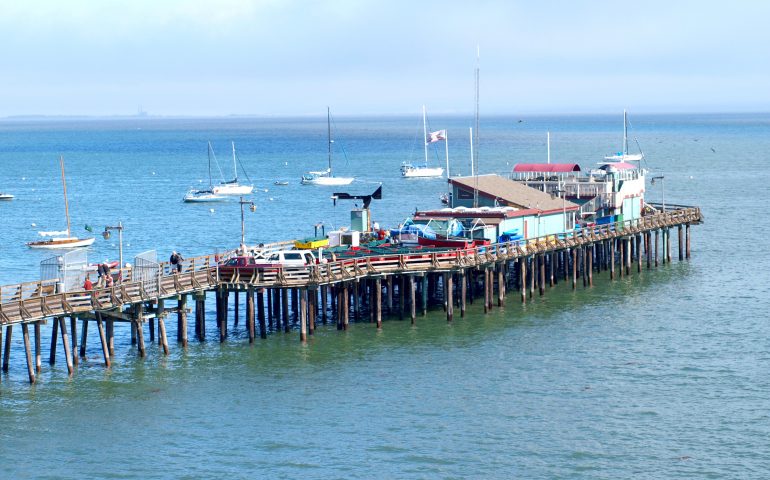
Any handicap parking ? Parking information
There is, at the base of the pier and some on the pier itself.
id like to know some tips on how to catch striper at this pier. Whats the best season? bait? and how to use them
Tips are given in the article in regard to bait. As for the season, it can be from late spring into the fall months but it varies year to year depending largely upon water temperatures and bait in the area.
These days, the area is home to eateries, chic tourist stores, and art galleries.
I really love the peaceful scenery here, it’s great that I got to visit Capitola Wharf once
I agree
Great resource for planning a day at the wharf!
Here that is usually OK since there is usually a plethora of smaller species available most of the year.
My understanding is that regular housework is a great method to keep players happy and engaged.
Capitola Wharf looks so nice and people love to be here and spend time sunbathing and fishing. You have shared an amazing detail for us.
While browsing for user-friendly platforms, I stumbled upon Reddy Anna and was intrigued by how much it’s talked about. The clean design and real-time updates make it stand out in a sea of clunky interfaces. I appreciated how quickly you can get up and running—no complicated steps or confusing menus. It’s like they actually listened to what users want. Definitely a smart move on their part.
Thank you for your cooperation with our project. Your help is highly valued.
This is the kind of content I love reading here. Thanks for sharing!